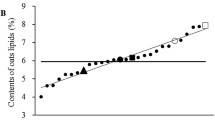Abstract
This study was undertaken to assess the effect of blended oils, i.e., polyunsaturated fatty acid (PUFA) rich vegetable oils like safflower oil (SFO) and sunflower oil (SNO) with the unconventional and hypocholesterolemic rice bran oil (RBO) on the serum lipid profile of rats. Rats fed RBO + SNO/SFO at 70:30 ratio for a period of 28 days showed significantly (p < 0.05) lower levels of total cholesterol (TC), triglycerides (TG) and low density lipoprotein (LDL) cholesterol and increased high density lipoprotein (HDL) cholesterol in animals fed a high cholesterol diet (HCD) and cholesterol free diet (CFD). Liver total cholesterol (TC) and triglycerides (TG) were also reduced. Fecal excretion of neutral sterols and bile acids was increased with use of RBO blends. RBO, which is rich in tocopherols and tocotrienols, may improve the oxidative stability of the blends. Tocotrienols are known to inhibit 3-hydroxy, 3-methyl, glutaryl CoA (HMG-COA) reductase (rate limiting enzyme in cholesterol biosynthesis), resulting in hypocholesterolemia. In addition to improving the lipid profile by lowering TC, TG and LDL-C and increasing HDL-C, blending of RBO with other oils can result in an economic advantage of lower prices.
Similar content being viewed by others
References
Rao MV (1988) Non-conventional area, season, crop and technology approach to meet the vegetable oil shortage in India. J Oilseeds Research 5: 16-18.
Lewis YS (1986) Blending of edible oils allowed. Food Policy, Indian Food Industry 5: 101.
Rukmini C (1987) Toxicity studies on unconventional oils. Proc Nutr Soc India 33: 1-7.
Manorama R, Chinnasamy N, Rukmini C (1993) Multigeneration studies on red palm oil and hydrogenated vegetable oil containing mahua oil. Food Chem Toxicol 31: 369-375.
Chinnasamy N, Harishankar N, Uday Kumar P, Rukmini C (1993) Toxicological studies on debitterised neem oil (Azadiracta indica). Food Chem Toxicol 31: 297-301.
Rukmini C (1988) Chemical, nutritional and toxicological studies on rice bran oil. Food Chem 30: 257-268.
Raghuram TC, Brahmaji Rao V, Rukmini C (1989) Studies on hypolipidemic effect of dietary RBO in human subjects. Nutrition Reports International 39: 889-895.
Shepard J, Packard CJ, Patsh JR, Gotto AM, Taunton OD (1978) Effects of dietary polyunsaturated and saturated fats on the properties of HDL and the metabolism of apolipoprotein A-1. J Clin Investigation 61: 1582-1592.
Schaefer EJ, Levy RI, Ernst ND, Van Sant FD, Brewer HB Jr (1981) The effect of low cholesterol, high polyunsaturated fat and low fat diets on plasma lipid and lipoprotein cholesterol levels in normal and hypocholesterolemic subjects. Am J Clinical Nutr 34: 1758-1763.
Mattson FH, Grundy SM (1985) Comparison of effects of dietary saturated, monounsaturated and polyunsaturated fatty acids on plasma lipids and lipoproteins in man. Lipid Research 20: 194-202.
Warlow GM, Snooj JT, Lin MC, Puangco MA, Kwon JS (1991) Serum lipid and apolipoprotein concentration in healthy men on diets enriched in either canola oil or safflower oils. Am J Clinical Nutr 54: 104-110.
Bringi NV (1987) In Nontraditional oils and oilseeds of India. New Delhi: Oxford and IBH Publishing Co.
Folch J, Lees M, Stanley GMS (1957) A simple method for isolation and purification of total lipids from animal tissues. J Biol Chem 226: 497-498.
AOAC (1984) Determination of iodine value and saponification value in foods. Official methods of analysis (14th edn.), pp. 503-532. Washington, DC: Association of Official Analytical Chemists.
AOAC (1990) Determination of acid value foods, pp. 103-104. Washington, DC: Association of Official Analytical Chemists.
Kishimoto Y, Hoshi M (1972) In R. Fried (ed), Methods of neurochemistry 3: 81-85.
Syvaoja EL, Piironen V, Varo P, Koivistoinen P, Salminen K (1986) Tocopherols and tocotrienols in Finnish foods - fats and oils. J Am Oil Chem Soc 63: 328-329.
Wybenga L, Dillegi K (1977) Estimation of total cholesterol. Clinical Chem 22: 165-166.
Foster LB, Dunn RT (1973) A simple colorimetric method for determination of triglycerides. Clinical Chem 19: 338-341.
Snell FD, Snell GT (1961) Colorimetric methods of analysis, Vol. 3A, pp. 350-356. New York: Van Norstrand.
Spritz N, Mishkell C (1965) Effect of fatty acid saturation on the distribution of plasma lipids and lipoproteins, a hypothesis for the lipid lowering effect of unsaturated fatty acids. J Clin Investigation 48: 78-84.
Sharma RD, Rukmini C (1987) Hypocholesterolemic activity of unsaponifiable matter of rice bran oil. Indian J Med Research 85: 278-281.
Grundy SM (1975) Effects of PUFA on lipid metabolism in patients with hypertriglyceridimia. J Clin Investigation 55: 249-256.
Lewis B, Pilkington TR, Hodd KA (1961) A mechanism for the action of unsaturated fat in reducing cholesterol. Clinical Science (London) 20: 249-256.
Larsen P (1970) The Oslo diet heart study. Eleven year report. Circulation 21: 935-941.
Bloomfield DK (1964) Cholesterol metabolism III. Enhancement of cholesterol absorption and accumulation in safflower oil diets. J Lab Clin Med 64: 613-625.
Avigan J, Steinberg D (1965) Sterol and bile acid excretion in man and the effect of dietary fat. J Clin Investigation 44: 1845-1853.
Spritz N (1965) Effect of fatty acid saturation on the distribution of the cholesterol moiety of VLDL. J Clinical Investigation 44: 334-343.
Sharma RD, Rukmini C (1986) Rice Bran and hypocholesterolemia in rats. Lipids 21: 715-720.
Rukmini C, Raghuram TC (1991) Nutritional significance of Rice bran oil. J Am College of Nutrition 10: 593-601.
Qureshi AA, Burger WC, Peterson DM, Elson CE (1986) The structure of an inhibitor of cholesterol biosynthesis from barley. J Biol Chem 261: 10544-10550.
Author information
Authors and Affiliations
Rights and permissions
About this article
Cite this article
Sunitha, T., Manorama, R. & Rukmini, C. Lipid profile of rats fed blends of rice bran oil in combination with sunflower and safflower oil. Plant Foods Hum Nutr 51, 219–230 (1997). https://doi.org/10.1023/A:1007993016796
Issue Date:
DOI: https://doi.org/10.1023/A:1007993016796




